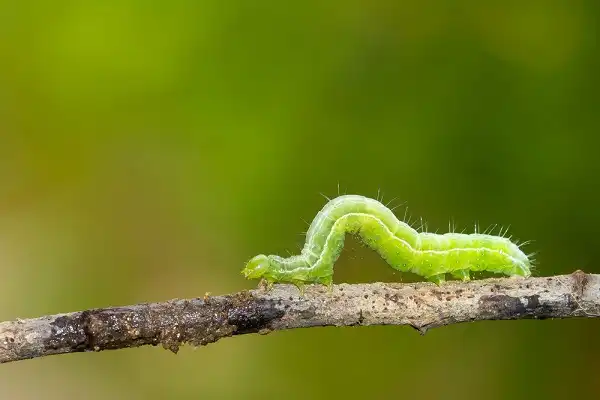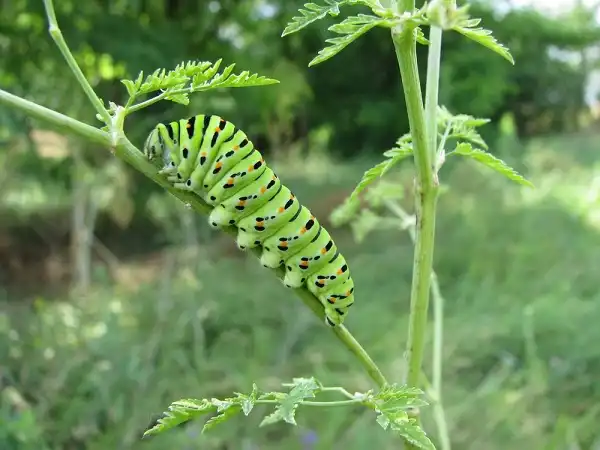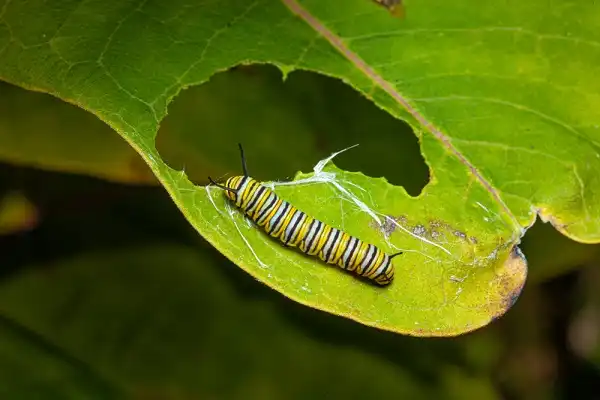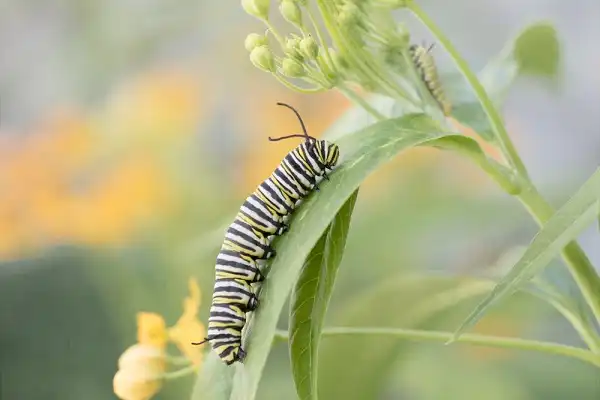Caterpillars are an unmistakable creature, well known for their ability to transform into beautiful butterflies. Along with being able to construct cocoons and travel far distances, these little critters have captivated nature lovers and scientists alike for centuries. Whether you’re a butterfly enthusiast or simply awe-struck by the power of metamorphosis, this blog post will take a closer look at the caterpillar – what it is, how it lives, and why so many people find them so fascinating. With interesting facts about biology lessons behind us all from childhood days in grade school science class mixed with some modern-day interpretations of learning about the natural world around us – come explore our journey as we learn more about the amazing life cycle of this extraordinary insect!

Caterpillar Description
Caterpillars are small, worm-like larvae of the order Lepidoptera. They typically have soft bodies and vary in color depending on species, but are often green or brown with bands or stripes of contrasting color. They have six legs and two antennae, and their bodies are segmented into multiple sections. Caterpillars feed voraciously, typically on the leaves of plants, but some caterpillars are known to feed on other creatures such as hairless mammals. Caterpillars also possess a wide array of defense mechanisms to ward off potential predators. Some species are camouflaged to blend into their environment while others employ bright colors as warning signals that they may be poisonous or unpalatable. Many caterpillars also secrete substances from glands on their body that can be distasteful or toxic to predators.
Caterpillar Habitat
Caterpillars are found in a wide variety of habitats all around the world, from tropical rainforests to arid deserts. They typically prefer warm climates and moist soil, but some species can also be found in colder temperate regions. Depending on the species, caterpillars can be found living in trees, grassland, or even on the ground. The type of habitat that a caterpillar lives in will play an important role in its life cycle. Many species rely on particular plants and resources available only within certain geographic areas or elevation ranges. Not only do these places provide food for caterpillars, but they also provide shelter from predators or extreme weather conditions. Caterpillars have developed a number of different strategies for surviving in their habitats. Some species build nests out of silk and leaves to protect themselves from predators or inclement weather. Other species use camouflage to blend into their surroundings to avoid detection by predators.
Caterpillar Diet
Caterpillars have a wide range of diets, but most often feed on the leaves and stems of plants. Depending on the species, they can eat almost any type of plant material including grasses, fruits, flowers, and shrubs. Additionally, some species are known to snack on other animals such as hairless mammals or snails! Most caterpillars graze on several different types of leaves and prefer to eat fresh ones. They also have an incredibly voracious appetite; in fact, it’s common for them to consume five times their own body weight in food each day! As caterpillars grow bigger and their bodies become more complex, their diet grows along with them.
They may start off eating leaves from one type of plant before transitioning to another as they reach adulthood. Caterpillars possess several unique adaptations that make them well-suited for a leaf-eating lifestyle. For instance, many have specialized mouthparts that allow them to cut through tough plant cells and extract the nutritious juices inside without wasting excess energy. In addition to being able to digest high amounts of cellulose (a structural component found in plant cell walls) the caterpillar’s gut is also home to a variety of beneficial microorganisms which help break down the food even further.

Caterpillar Size
Caterpillars come in a variety of sizes. Most are between 1/8 to 2 ½ inches in length, although some species can grow up to 4 inches long. Their size is often determined by the type and amount of food they consume as well as the temperature of their environment. Caterpillars may also appear bigger or smaller than expected due to their unique defense mechanisms. No matter what size they may appear to be, caterpillars play an important role in the environment by providing food for birds and other animals while helping plants propagate through pollination when they become butterflies. They are truly remarkable creatures that deserve our admiration!
Caterpillar Lifespan
Caterpillar lifespan depends on a variety of factors such as the species they belong to, their environment, and the resources available to them. Generally speaking, most caterpillars can expect to live anywhere from 2 weeks to several months; however, there are some species that may live for up to 4 years! In terms of the life cycle of a caterpillar, they usually begin as eggs that hatch within 2 weeks. After hatching, they immediately enter into their larval stage which is when they feed and grow in size until they reach adulthood. Once they become adults, many species will seek out a suitable place to pupate and form a cocoon in order for them to transition from larvae into adult butterflies.
This process can take anywhere from several days to several weeks depending on the species and environmental conditions. Once this transformation is complete, adult butterflies typically have a lifespan ranging anywhere from one week up to several months – again depending on the type of butterfly and its surrounding environment. During this time, these beautiful creatures will feed on nectar and pollen from flowers while also helping propagate plants through pollination. They may even travel hundreds of miles for food or during migrations!
Caterpillar Behavior
Caterpillars have a range of behaviors they use to survive in their environment. One common behavior is the process of camouflage, where caterpillars will blend into their surroundings to avoid detection by predators. This can be achieved through changes in coloration or texture, such as stripes or spots that resemble leaves or other foliage. Some species also make use of mimicry, whereby they “dress up” as other animals or objects to disguise themselves and remain hidden from potential threats.
In addition to this, many species are known for their complex social interactions with one another. These include grooming and communication through pheromones that allow them to form temporary communities and even recognize specific individuals from the group. They may also cooperate when building nests or webs, which provide protection during their vulnerable early stages of life. Lastly, some species exhibit fascinating defensive behaviors such as “playing dead” or emitting foul odors when disturbed by a threat – an effective way for them to protect themselves! All these behaviors demonstrate how sophisticated and adaptive these creatures are; amazing considering how small and delicate they appear!

Caterpillar Speed
Caterpillar speed can vary significantly depending on the species, environmental conditions, and stage of life. Generally speaking, most caterpillars move at a slow to moderate pace as they search for food and explore their surroundings. The majority of them crawl using their six legs and two antennae to guide them, although some species may use an inchworm-like motion to move more quickly over short distances. One species known for its impressive speed is the Army cutworm moth caterpillar which can travel up to 20 feet per minute when disturbed! However, this type of movement is usually only seen in response to a perceived threat or when searching for a suitable place to form its cocoon.
Caterpillar Communication
Caterpillar communication is an interesting and varied behavior that helps these creatures survive and thrive in their environment. Many caterpillar species use a variety of methods to communicate with one another, including tactile signals, pheromones, and visual cues such as posturing or changing colors. One common method of communication for caterpillars is the use of physical contact such as tapping or rubbing against other individuals. This behavior can be used to show submission or dominance among group members, as well as for recognition purposes.
Some species also use pheromones to mark their territory or attract potential mates – these scents are typically produced through secretions from glands located on the body. Visual signals are also widely used among caterpillars; they can signal excitement or anger by changing color, flicking antennae, raising hairs on their back, arching their bodies into specific shapes, or even extending certain body parts such as legs. In addition to this, some species make use of sound production by vibrating certain parts of their body in order to communicate with other individuals in the group.
Caterpillar Hunting
Caterpillar hunting is a common behavior seen in many species of caterpillars. It involves the caterpillars actively searching for prey, usually smaller insects such as aphids, ants, or termites. When on the hunt, some species will actively stalk their victims while others may lay in wait and ambush unsuspecting prey that comes too close. The hunting process begins with the caterpillar using its senses of smell and sight to search for potential food sources. Caterpillars have two primary methods of capturing their prey; they can either use their mandibles to bite through their victim’s exoskeleton or inject them with venomous saliva that soon paralyzes the target and makes it easy to devour. After finding a suitable meal, the caterpillar will then begin consuming its victim slowly and carefully so as not to damage any vital organs until the entire body has been consumed. This helps ensure that the nutrients from its meals are efficiently absorbed before moving on to find more food.

Conclusion
Caterpillars are fascinating creatures that demonstrate a remarkable level of adaptation and intelligence. Their ability to move, communicate and hunt for food helps ensure their survival in the wild and allows them to thrive in a variety of environments. By understanding how these behaviors work, we can better appreciate just how complex and adaptive these tiny creatures truly are! This knowledge also serves as a reminder of the importance of conservation efforts aimed at preserving species from all corners of the natural world. Every creature deserves its place on our planet, no matter how small or seemingly insignificant it may be.
Frequently Asked Question

